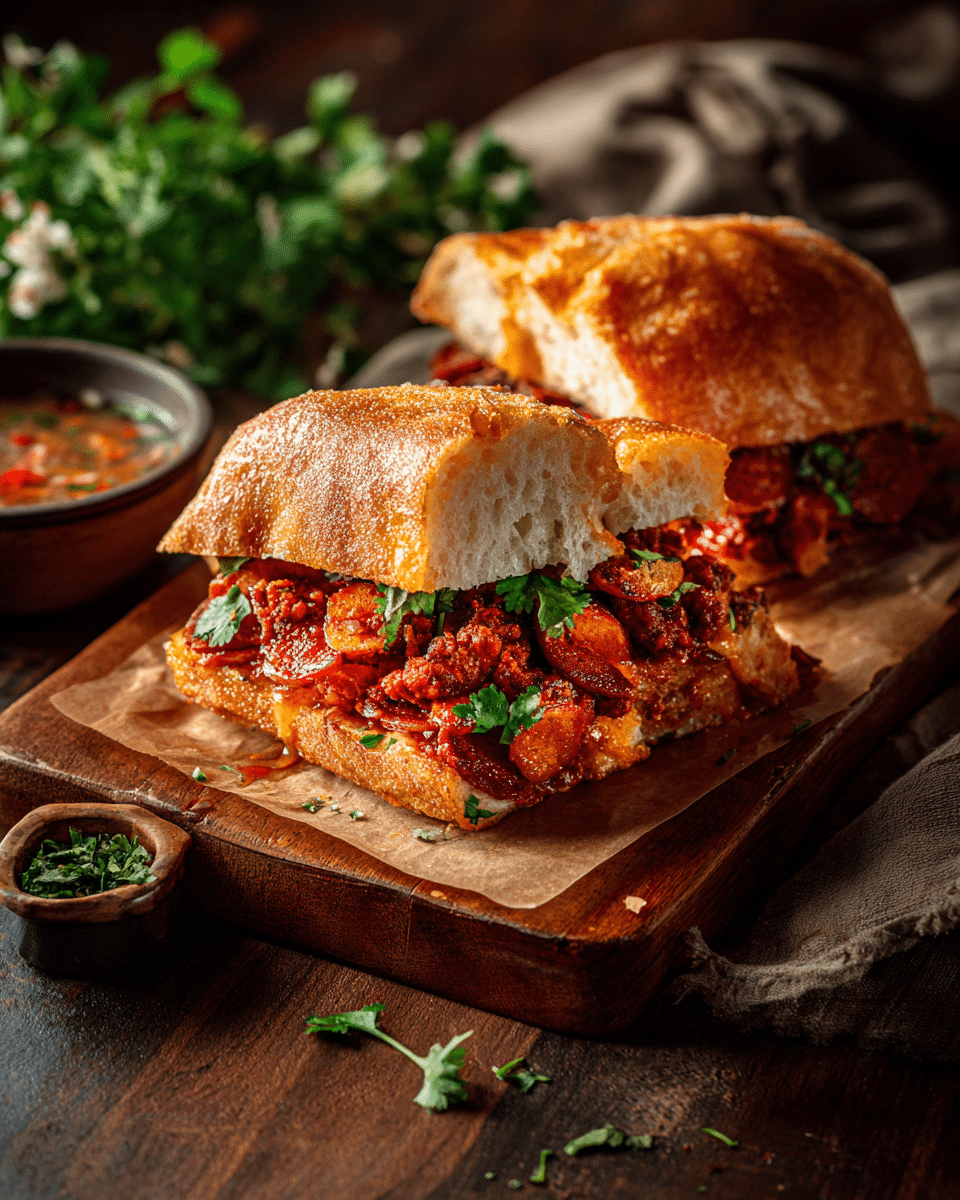The pambazo is a beloved Mexican sandwich known for its distinct red bread, dipped in a flavorful guajillo chili sauce before being lightly fried. Traditionally stuffed with potatoes and chorizo, lettuce, crema, and cheese, it is especially popular during Mexican Independence Day celebrations.
FULL RECIPE
Ingredients
- 4 pambazo bread rolls (or telera/bolillo rolls)
- 6 dried guajillo chiles, stems and seeds removed
- 2 cloves garlic
- 1 cup water (for blending)
- 1 tbsp vegetable oil (for the sauce)
- 250 g (about 9 oz) Mexican chorizo, casing removed
- 2 medium potatoes, peeled and diced
- 2 tbsp vegetable oil (for frying sandwiches)
- 1 cup shredded lettuce
- 1 cup crumbled queso fresco
- 1/2 cup Mexican crema (or sour cream)
- Salt, to taste
Directions
- Prepare the sauce: In a pot, boil the guajillo chiles for 5 minutes until softened. Drain and transfer to a blender along with garlic and 1 cup water. Blend until smooth.
- Heat 1 tbsp vegetable oil in a skillet over medium heat. Strain the blended chili sauce into the pan, season with salt, and simmer for 5 minutes. Remove from heat and set aside.
- Cook the potatoes: In a small pot, boil the diced potatoes in salted water for about 8 minutes, or until tender. Drain and set aside.
- Cook the chorizo: Heat a skillet over medium heat, add the chorizo, and cook for 5 minutes, breaking it apart. Add the cooked potatoes and stir to combine. Cook for another 3 minutes. Remove from heat.
- Dip the bread: Slice the pambazo rolls in half (without cutting all the way through). Dip each roll into the guajillo sauce, coating all sides well.
- Fry the bread: Heat 2 tbsp vegetable oil in a large skillet over medium heat. Place the sauce-coated rolls in the pan and fry each side for 1–2 minutes until slightly crisp but still soft inside.
- Assemble the sandwich: Fill each roll with the potato-chorizo mixture. Top with shredded lettuce, queso fresco, and a drizzle of crema.
- Serve warm and enjoy.
Nutrition Facts
- Calories: 520
- Protein: 18 g
- Fat: 29 g
- Saturated Fat: 10 g
- Carbohydrates: 48 g
- Fiber: 6 g
- Sugars: 4 g
- Sodium: 980 mg
Historical Significance of Pambazo
The pambazo is deeply rooted in Mexican culinary tradition, with origins tracing back to the colonial era. The name is believed to come from “pan basso,” a type of bread made for lower-income communities, which over time evolved into a celebrated street food. While its humble beginnings were tied to affordability, today it is enjoyed by all social classes and is particularly prominent during festivals like Mexican Independence Day. The sandwich’s red color, achieved by soaking bread in guajillo chili sauce, is symbolic of Mexico’s vibrant culture and passion for bold flavors. In many regions, the pambazo is more than just a meal—it’s a representation of heritage, community, and celebration.
Cultural Role During Mexican Independence Day
Pambazos hold a special place in Independence Day festivities, often sold at street fairs and public gatherings. The striking red bread mirrors the colors of the Mexican flag when paired with white crema and green lettuce, making it a fitting culinary symbol for the holiday. Street vendors prepare them in large batches to feed crowds, and families often make them at home as part of multi-course celebratory meals. Eating a pambazo during this national holiday is both a gastronomic pleasure and a way to connect with cultural identity.
Flavor Profile and Texture
One of the defining traits of a pambazo is its unique combination of textures and flavors. The bread, once dipped in guajillo sauce and fried, becomes slightly crisp on the outside yet remains soft inside. The filling, typically a mix of chorizo and potatoes, provides a rich, spicy, and savory core, complemented by the freshness of shredded lettuce. Creamy Mexican crema and crumbly queso fresco add a cooling balance to the spiciness, while the guajillo sauce delivers a deep, earthy smokiness with mild heat. Each bite offers contrast—soft and crunchy, spicy and creamy, savory and fresh.
Nutritional Considerations
While pambazos are indulgent street food, they can be adjusted to meet various nutritional needs. Chorizo is a rich source of protein but also high in saturated fats, so using leaner alternatives like turkey chorizo can reduce calorie and fat content. Potatoes offer dietary fiber and essential minerals, while guajillo chiles are rich in vitamin C and antioxidants. The use of lettuce and fresh cheese also adds micronutrients like calcium and vitamin K. Balancing portion sizes and pairing the sandwich with fresh vegetables or a side salad can make it part of a more balanced meal.
Popular Variations Across Mexico
Though the potato-and-chorizo version is the most famous, many regions in Mexico adapt the pambazo to suit local tastes. In some areas, it is stuffed with shredded chicken, refried beans, or carnitas. Coastal regions might incorporate seafood-based fillings, while vegetarian versions may use mushrooms, nopales, or grilled vegetables. The guajillo sauce can also be replaced or enhanced with other dried chiles like ancho or pasilla for deeper flavor or more heat. These variations allow the pambazo to evolve while still preserving its essential identity as a fried red bread sandwich.
Serving and Presentation Tips
Presentation can enhance the appeal of pambazos, especially when serving them at parties or special events. Arranging them on a large platter with vibrant garnishes like pickled jalapeños, avocado slices, and radish rounds adds visual interest. Serving them freshly fried is crucial for maintaining texture, but keeping the fillings warm separately and assembling just before eating ensures freshness for larger gatherings. Offering extra guajillo sauce or crema on the side allows guests to customize the richness and spice level to their preference.
Ideal Pairings and Beverages
Pambazos pair wonderfully with traditional Mexican drinks such as agua fresca, horchata, or tamarind juice, which help balance the spiciness of the chorizo and chile sauce. For those who enjoy alcoholic pairings, a light Mexican lager or a michelada complements the sandwich without overpowering its flavors. Side dishes like elote (Mexican street corn), nopales salad, or black beans work well to round out the meal. The combination of flavors, colors, and textures makes pambazos a versatile dish for casual or festive dining.
Storage and Reheating Advice
While pambazos are best eaten fresh, they can be stored for later enjoyment with some adjustments. The bread can be dipped in the guajillo sauce and refrigerated separately from the filling to prevent sogginess. Both bread and filling can be stored in airtight containers in the refrigerator for up to two days. To reheat, warm the bread in a lightly oiled skillet until crisp again, and heat the filling in a separate pan before assembling. Freezing is not recommended, as the texture of the bread and potatoes may suffer.
Tips for Making a Healthier Version
For a lighter version of pambazos, consider baking the sauce-coated bread instead of frying, which reduces oil absorption. Using whole wheat rolls can increase fiber content, and replacing regular chorizo with chicken or vegetarian chorizo lowers fat. Sweet potatoes can be substituted for white potatoes to add beta-carotene and a natural sweetness. Reducing cheese and crema or using lower-fat alternatives can also improve nutritional balance. With these modifications, the pambazo can retain its delicious essence while becoming more suitable for everyday meals.
Why Guajillo Chiles Are Essential
Guajillo chiles are the backbone of pambazo’s signature red bread, providing both flavor and color. They are mildly spicy, making them accessible to a wide range of palates, and their earthy, fruity notes complement the richness of chorizo perfectly. Beyond taste, guajillos contribute antioxidants and vitamin C, adding subtle health benefits. Using dried guajillo chiles and toasting them lightly before soaking can deepen their flavor. While substitutions are possible, guajillo chiles remain the classic choice for authenticity and tradition.
Conclusion
The pambazo sandwich with chorizo is more than a delicious street food—it’s a celebration of Mexican heritage, creativity, and flavor. From its roots in colonial history to its starring role in Independence Day festivities, the pambazo has evolved into a dish that unites tradition with personal expression through countless regional variations. Its vibrant colors, contrasting textures, and rich flavors make it a standout in Mexican cuisine, whether enjoyed from a street vendor’s griddle or prepared at home for friends and family.






